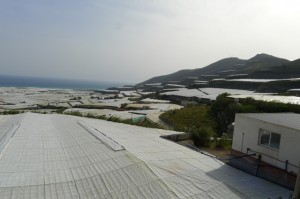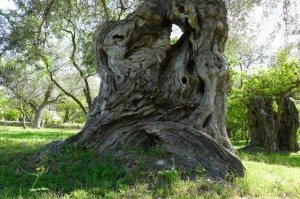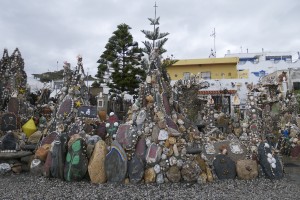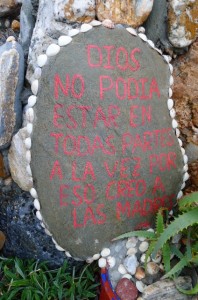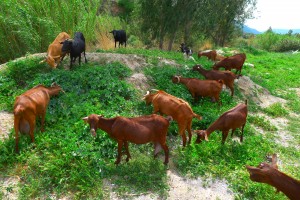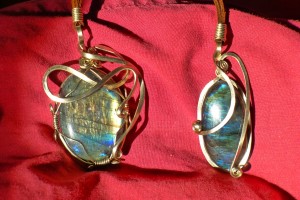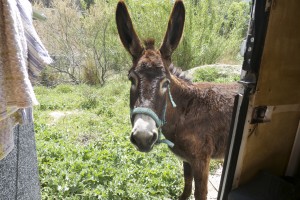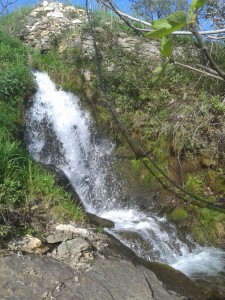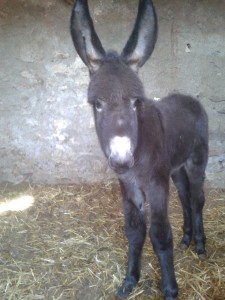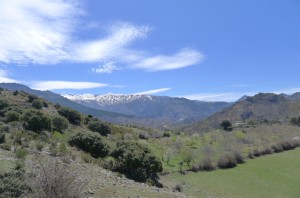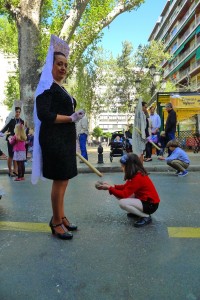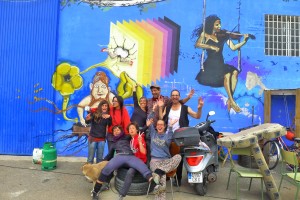Government decisions. The good news and the bad news…
We take a day trip to Almeria in order to pick up a parcel from the post office there. Almost immediately upon leaving Motril, we are surrounded by what we call ‘the sea of plastic’. It’s over 100 km from Motril to Almeria, and, except for a few kilometres where the road goes through very rough and rocky mountains, the whole area is covered in greenhouses as far as the eye can see.
It is shocking – this is the result of our need to have fresh vegetables, tomatoes, aubergines, peppers, lettuces etc. every day of the year. In timely fashion, someone posts this article on facebook only days after we have passed the Sea of Plastic. The human cost described in it is deeply shocking. In addition to that, we wonder what happens to water. We are told that water gets mixed with chemicals before it flows through to feed the plants. We dread to think what comes out the other end. Also, the sheer amount of water needed to feed all these greenhouses must mean that water is lacking elsewhere. Thirdly, any rainfall does not get absorbed by the earth but just runs off the plastic into the gulleys and down to the sea, probably bringing with it a hefty amount of chemicals. Fourthly, such a large area covered with plastic would also affect the local climate. We heard from Miguel that chemtrails are rife in the area, and we wonder whether the government has to influence the weather because otherwise there wouldn’t be any rain anymore at all, as there is no water to evaporate. Everything about this seems so wrong. Last but not least the implications of using so much plastic… another article appears on Facebook, discussing whether it is time to rank plastic as a hazardous substance.
Between the sea of plastic and the Mediterranean is a small strip of beaches and holiday hotels. Just like they say in the article, the tourists who come to roast on the beaches have no idea what’s going on just a few hundred metres behind their backs. It really is shocking.
We wonder how much of this is local government policy. To the right of Motril, there are hardly any greenhouses visible, and in the area around Orgiva, which is only 30km away, there is nothing of the sort. We also wonder if damaged land like this can be reclaimed, and if so how, and how many years would it take for the area to recover.
We pass a sign for organic growers. However, they may well be operating on a huge scale, and apparently are just as liable to exploit their workers, if not quite so drastically as to spray them with chemicals. The organic tomatoes we find on our supermarket shelves in England don’t tell us anything about the conditions under which the people had to work…
The good news is that in other areas, local governments seem to have had their heads more screwed on about how they would like their area to develop. Orgiva has an incredibly beautiful ‘Ruta de Olivos’ letting people see these Olive trees that are hundreds of years old. We pass one farmer on a little three-wheeler put-put with an inbuilt, flatback trailer. He is full of pride when he tells us where the biggest trees are, some with a circumference that even 5 people can’t stretch their arms around, and that they are so old that his grandfather who is now 90 years old remembers them as big old trees in his childhood. We walk through lanes where the only sound is that of the water from the Azequias and the singing of birds, where Orange blossom permeates the air and the rich colours of poppies, Roses, Lilies and many wild flowers delight the eye. People use the land beneath the olive trees to grow beans, leeks, greens, lettuce etc. There are many houses dotted about the place, each house having a bit of terraced land with it. There is no one great big enterprise with fields stretching on for kilometre after kilometre.
We take Emma up the mountain from Orgiva to visit a little village at the top, called Capilleira. We park by an abandoned municipal building that looks like it might have been a youth hostel some time ago. When we ask the locals, we hear that almost as soon as the building and its surrounding garden and swimming pool were built, it was shut – for no apparent reason other than lack of money. It is a beautiful spot and it hurts to see so much public money having been spent and such amenities falling to ruin. The swimming pool has never been used by anyone else than frogs who hop on and off the ladders to get in and out. A local farmer tells us that for one year, the place was run by some people who held a course there about herbal medicine. They build a greenhouse and planted many medicinal herbs in it and in the garden. But at the end of the year, the course closed down, and local shepherd allowed their flock to graze on the land, thus destroying the carefully designed garden.
We wonder what happened here. Was there someone in the local government who had drive and started a project, only to be replaced by someone who had other priorities?
So much local public money has gone into this, and nothing comes out of it – why does the local population not complain more, why don’t they take initiative? We think back on our visit to Chaos in Portugal, and how a similar project could thrive here too, but of course it would need the vision of someone in the village and make it a project that would benefit the whole community.
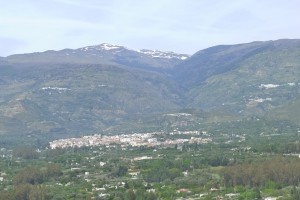
The town of Órgiva in the foreground, further up in the hills Cañas, Pampaneira, Bubión and Capilleira, and the Sierra Nevada, still partially covered in snow, in the background.
For more photos, including the beautiful ancient Olive trees, go to flikr.
Posted in Uncategorizedwith no comments yet.
Neighbours
One of the great delights of travelling is your constantly changing neighbours. One morning, we wake up down by the sea in a tiny village that time forgot, about half way between Motril and Almeria. A three minute walk on the beach takes us to a very interesting neighbour, Maria Rodriguez, who has spent about 10 years creating this extraordinary sculpture garden outside her house, facing the beach.
At our parking space below Orgiva, there is a quite a lot of passing traffic, but it is at a leisurely pace. As mentioned in a previous chapter, there is a donkey, who comes right up to you, looking for company. There’s also a horse that is tethered on the wild grass for a few hours each day. Later in the day, a goat herd passes through with about 30 very well-fed goats and a handful of dogs.
One night, an Italian couple park their van near us. We meet the next morning and after an hour or so of chatting, invite them to lunch. Frank happened to cook a pasta dish. Given the choice of using our pasta or theirs directly imported from Italy, the Italians choose their home spaghetti. They also bring a bottle of Chinotto, a slightly bitter drink from a fruit similar to a mandarin, and a sweet tomato puree made by the slow cook movement. Frank’s Ratatouille passes the Italian test, he gets the nod of approval 
They are very friendly and invite us to use their internet in the house they have rented a couple of hundred metres up the road, so we have a good session catching up with family and friends and sorting out Tango Mango bookings. Every time I see a booking of someone from the ‘Mango Family’, I look forward to our return in the Summer, to spending 10 days with all you precious people; dancing, reconnecting, teaching, laughing, chatting and playing some of this delightful music in the Orquesta.
*****
For more photos especially of the sculpture garden, go to flikr. I’ve translated the sayings, you can read the translation if you hover your cursor over the picture.
Posted in Uncategorizedwith 1 comment.
Sunday in Órgiva
Once a month, there is a second hand market in Órgiva, so we arrange with Lynda to show us a nice way up from the river where we are parked to the centre of town.
By the time Lynda arrives, we are not quite ready – the mornings seems to draw out, what with getting Emma shipshape and me practising my bandoneón, and not to forget a leisurely two course breakfast… Frank has bought me a metronome, so now I am seriously improving on my speed for the variaciones of Juan D’Arienzo’s pieces, practising every day for the Orquesta Tipica of this Summer’s Tango Mango.
Linda and her dog have been here for many years, they know every little path. For a little while, we follow the Ruta de Olivos, admiring the ancient olive trees and listening to the many stories that Lynda knows to tell about the people who live either side of the lane before she turns off down a little path and into the fairly dry riverbed. We walk up the hill in the shade of the steep banks, coming out at the bottom of town where the gypsies keep their animals. The market is in full flow with about 30 stalls, offering all sorts of second hand things plus a few stalls with handmade items of leather and jewellery, soaps and stained glass.
I find an outlandish hat – well needed as the sun is really getting hot these days – Frank swaps some of the books we have read with new ones and we chat to quite a few stallholders. We come across a stall with a lot of very beautifully crafted jewellery where one particular pendant, a Labradite set in a swirl of silver, really calls out to me. We spend a bit more time going up and down the market before returning to the stall, only to see a second pendant, equally beautiful but different. In the end, we decide to buy both of them, they kind of go in a pair, and as we hadn’t got round to sorting out wedding rings in time for our marriage, this feels like they might be our wedding pendants.
We stroll back home with our riches, choosing another way down the hill and discover that there is a little Steiner School, set in an old olive grove (we’ll get some photos in the next couple of days when there are children), as well as a Sufi community and various other communities, all right next to each other. It all looks very beautiful and calm and quiet, with the terraces dropping down to the river, and these ancient olives everywhere.
Back home, Frank prepares lunch while I have a quick dip in the river to cool down. We have a visitor too, a very nosy donkey, looking for company…
Posted in Uncategorizedwith 3 comments.
Healers
A note of warning: This chapter touches on two taboo topics – the prostate, and the question of how we deal with shit. I have written this chapter because I think it is important to bring attention to these topics, to lift the veil of silence. Only if we address these things more openly can we hope for proper progress to be made and better solutions to be found.
I don’t want to force anyone to think about this though, so if you prefer not to, feel free to move on to another chapter!
******
In our search to find someone who can help Frank find out what’s troubling his health, we’ve been given a telephone number for a naturopath in Motril, called Miguel.
Miguel is a calm and smiling man, originally from the Basque country but resident in the Alpujarras for the last 30 years. He practises a particular type of massage invented by a doctor from the Basque country and a Korean acupressure performed on the hand. Both work on the principle of finding blockages and helping the body to remove the blockages. Part of the first massage was diagnostic just as much as remedial. The Korean hand therapy uses a little metal instrument not dissimilar to a crochet-hook to find and then press certain painful points in the hand.
Miguel is convinced that if Frank uses this method every three hours, that after a month, he will be free of the problems in his prostate.
However, that night, the infection comes to a head and we go off to the hospital in Granada (see our description a couple of chapters ago). Their prescription of antibiotics helps with the immediate pain but doesn’t address the cause, so we are back to square one. We know we need to find a doctor who can do an examination, or failing that, can refer us to a urologist.
We contact Miguel again, in the hope that he can help us find someone. He invites us to his house the following day, where we meet his lovely partner and two daughters. Miguel gives Frank another treatment and asks us to stay for lunch and to come with them in the afternoon to see his other house up on the hill.
We pile into the car and drive up a very steep path until we reach his little Finca about 3km above Lanjarón. This is a magic place with stunning views across the valley and all the way down to the sea. On a clear day, Miguel says, you can see the Atlas Mountains in Morocco! A fast-flowing, cold and clear brook tumbles across the rocks and gushes down the gulleys.
It is this stream and its rocks that drew Miguel to buy this piece of land. The house that leans against the hillside is lovingly rebuilt, with lots of nooks and crannies, including a little secret balcony upstairs next to a wooden top room from where you have a 180 degree view facing southwards.
We meet the neighbour’s animals, including a baby donkey. It’s been a hot day, so they are quite thirsty. When I hold up a big bucket of fresh water to the horse, it empties it in one long draft.
Miguel and his partner disappear in different directions to prune plants and to direct the water in Moorish fashion to the vegetable beds, Frank finds a sunny spot to lie down and snooze, leaving 6 year old Violetta and me to linger in the sun outside the house. We have a long conversation about this and that. She is astute, friendly, open, and has some really interesting points to make. She is intrigued about how we solve the toilet question in our van, so I explain about our compost loo, how we separate the pee from the poo and that we cover each shit with a layer of a mix of sawdust and ashes. I tell her that it neutralises all odour, but she is not quite convinced. We talk about what happens with sewage normally, once you flush the toilet, and how costly it is to fish it back out of the water elsewhere and to clean the water.
I think it is good for the next generation to think about other ways of solving this dilemma. What a stupid idea to shit into the same water we want to drink! How can a so-called ‘civilisation’ end up with such an unimaginative solution.
In the evening, after several more painful Hand acupressure treatments, Miguel makes a number of phone calls to help us find a trusted doctor, and thanks to him, we have an appointment with Dr. Nur the following day in Motril.
Miguel and his family drive us down to Emma, and we show them our home. By the time we part from each other, it feels like saying good-bye to some very precious friends. We’ve had such a wonderful day up on their land with them, we received so much love and kindness from all three of them, it was much more than we expected.
We return to a place near Órgiva where we spend the night parked up by the river, feeling cocooned in our Emma and in the love of these special people. We have a night of sound sleep, despite a howling gale rattling the windows and buffeting the vehicle, making it rock like a boat in a storm.
At exactly 11.30 the next day, we ring the doorbell of Dr. Nur’s clinic in Motril. We have no idea what kind of a doctor he is, but everything on the desk in the reception says that he’s someone with an open mind to alternative therapies: the clinic offers Gynecology and Urology alongside Acupuncture and Osteopathy treatments. Dr. Nur, as we surmise from the many certificates hanging on the wall of his waiting room, has a passion for his profession and has studied medicine in many directions. It is a private clinic, where a thorough examination and analysis costs 100 Euros, but if you have to come back for a second diagnosis or treatment, it is free. Dr. Nur is an energetic man who radiates confidence. He asks Frank a series of questions, then takes his blood for analysis and gives him a thorough check, not just the prostate but everything: blood pressure, heart, lungs, bladder, kidneys and liver. It so reminds me of my Dad. He always said that a diagnosis needs to include the whole person, not just what the patient complains about. ‘Look and listen’, he used to say. When Dr. Nur calls us back into his office, the blood analysis is already there. He reads it like a book, and in combination with the rest of the check-up he can tell that Frank is very healthy and for sure has no cancer of the prostate but that his current problem is prostatitis for which he prescribes some natural remedies. When Frank mentions his trouble having to pee so frequently, he shrugs it off saying that this is not a problem of the bladder but of his Spina Bifida. Frank is completely bowled over – how did he know that he’s got a hidden Spina Bifida in two of his lower vertebrae? Dr. Nur smiles and says he feels passionate about his profession, he has the best diagnostic tools, better than hospitals and that there is no need for any invasive examination.
We leave the office quite relieved, but also speechless. How come that in some places Frank would have to have had a biopsy, and this doctor can tell us in such detail what’s what, just by closely looking and a thorough diagnosis of the blood? Why do so many men have to go through terrible discomfort and undergo potentially quite dangerous invasive examinations with less sure results?
Frank is a new man, the cloud of worry having lifted. We go off to find a restaurant to have a celebratory meal.
We thank all three healers, the hospital in Granada for helping us in an emergency, Miguel for the treatments and most of all for all the love, and Dr. Nur for a spectacularly detailed diagnosis and the confidence that comes from it.
Posted in Uncategorizedwith 4 comments.
Beneficio
On the way out of Órgiva, we pick up a hitchhiker who knows how to get to Beneficio. Without her, we would never have found it. On a sharp s-bend, we turn off onto a very rough and quite narrow dirt track, which leads to a rough car park by a stream. Frank is very tired, so we decide to stop and have a Siesta before visiting the community.
We have just dropped off to sleep when there’s a loud rapping on our door.
Frank jumps out of bed and goes out, I’m a bit slower to wake up and realise it’s the police! I quickly throw on some clothes but by the time I get out, they’ve already told Frank, in no uncertain terms, that we are camping illegally and in the riverbed of a national park and that we must leave immediately. I join the conversation, asking about the difference between parking and camping, and trying to understand the finer details of what exactly is forbidden, asking them to repeat or slow down so I can understand. After a few minutes, they say we can stay a couple of nights after all, but must keep the place neat and tidy. I assure them that we always leave the place tidier than we find it, and that we are very quiet people. We part on good terms.
I’m chuffed that my Spanish has improved such that I can converse with policemen and make them change their minds and their tone. Frank thinks the outcome has more to do with the fact that I wasn’t wearing a bra and thus made them go weak at the knees. Ah, well…
We stroll up the hill through the car park and into the woods. It is a very beautiful gorge, and people have made temporary living abodes of all kinds in the woods. Some are made of wood, others of all kinds of recycled materials. Some are very carefully constructed, with inner yards full of flowers, others are just very basic shacks. There is a great silence in the woods, save the sound of running water and numerous birds, despite the fact that there are quite a few people about the place. After a few hundred yards, the woods open and there are almond orchards, luscious meadows and vegetable gardens. There is a big Tipi functioning as a communal gathering and music-making space, where also twice a day, food gets made and shared with all who would like to partake.
A bit further up, there are several yurts and many other wooden buildings, each very individually designed. The sound of flowing water permeates the air, and we can hear children laughing and playing. We turn a corner and meet Noah (4) and Hoppy (2), the children of Edgar and Krista. We are invited into their garden and have a chat about the place, how it all started, who of the original people are still here if any, what the ethos is, where the purest water is etc. After a cup of tea, we explore a little further, as far as the waterfall and half way up the hill towards the solar internet café. It’s getting cold though and we’re concerned about spending too much energy (Frank is still quite weak from his illness), so we turn around and head for home.
Unfortunately, the loud music at the car park keeps us awake late into the night.
The next day, we take our bottles up to the source for drinking water. Once again, we meet Noah, who decides to come with us, first to the spring, and then back down to visit our van, so we spend best part of the day in the bright company of this charming young child. He really is the light of the day, because besides that, we are quite upset to see how much desolation there is, how many lost souls are wandering around here, how many very broken bodies we meet. This place was founded by a couple from Tipi Valley in Wales who wanted to live in harmony with nature. They bought a piece of land and started a small community, working along Permaculture principles. It must have been sheer heaven at that time – and there are some pockets where you can still sense the magic of this – for example by the waterfall and the spring, and when looking at the care and love with which some of the dwellings are built and the land around them is tended. But now, there are well over 100 people and drugs and alcohol are rife, especially around the bottom entrance by the car park. We hear that at one time, the river was contaminated with Hepatitis! As the original land became too small to accommodate new arrivals, people started to build their shelters into the national park, some times without respect for the things that grow there. Trees were felled, and we see quite a few broken branches or snapped off twigs along the paths. Some people have brought along their personal hell with them and it is too big for this place. Nature is a powerful healer and it did its best to accommodate the pain, but it seems that it cannot absorb the sheer amount of urban despair. Especially heart-breaking is to see small children wandering about in the car-park, looking lost, feral and uncared-for.
No wonder the police are called as soon as yet another traveller’s vehicle turns up on the hill. No wonder that the people who have built their shacks in the national park are being fined or taken to prison on a regular basis. It must be horrible for those who live below the community, to be disturbed by the incessant noise and ‘traffic’ and to have their water contaminated.
We cannot bear the thought of another night of ‘duf-duf’, so we decide to up and leave as the sun sets. We find a lovely camp site in Órgiva where we stay for a couple of nights.
Here are a few photos of taken in Beneficio, showing lovely Noah and his sister Hoppy and their mother, as well as the special spring and waterfall, and a beautifully flowering Jasmine.
Posted in Uncategorizedwith no comments yet.
Healing
There are a number of communities in the South of Andalucia where people have gathered to try out other forms of living together. We’ve been recommended to go and see some of them, especially those in the Alpujarras and down by the sea near Almerìa.
Our first stop once we leave Granada is a little beach near Motril, where we are told it is still possible to park right up by the beach and that we would be in the company of a few other vehicles like ours. A very steep dirt track leads down to a rocky beach with black sand. And indeed, there are a few more interesting vehicles here, but the inhabitants are quite different from us. Heavy duf-duf music, as we call it, pumps out of some of the wagons and everything looks a bit down and grungey, including the people. I’m not sure why I find this unsettling, apart from the fact that I’m not good around heavy use of dope.
Maybe it’s because we are united by the fact that we are travelling, but in other ways quite different, and sometimes being at such close quarters with some people, I reflect on my own life and start to worry about getting stuck in some kind of time warp of travelling without an inner light, without some kind of aspiration beyond just getting food and water and staying warm and out of the way of the police. It hasn’t got anything to do with what people look like but it is something inside. I had the same reaction on occasion when meeting some couples in their all mod-con ‘plastic-fantastic’ mobile homes, where conversations similarly revolved around a very limited number of topics. Frank assures me that there is no chance of me reducing myself and my life to that level…
We have a couple of photos on Flikr that convey the colours on that beach – shades of grey, but when the sun comes out there is colour too. The red dot is a sea anemone.
Anyway, we don’t actually mix that much with the other people on the beach – we came here to soak up sea air and help Frank recover from his heavy cold, which has had him in bed for best part of two weeks. We light the stove and open the doors, looking out on a windswept seascape. What a luxury, being lovely and warm inside, as well as having the fresh sea breeze wafting in. Frank sits on the bed and enjoys the sun, reading and sleeping. It’s been a hard month for him, having his mobility so reduced, first by a bad back, then a painful hip and then two weeks of a very heavy illness, which although it’s cleared, has left him very fragile and with a bladder problem. It’s a bit difficult without the usual support system of trusted osteopaths/acupuncture practitioners etc. around us, to get on top of all this, so the last month has been quite introverted in some ways. I have tried to still go out and dance, go for walks and see the sights around us, but it’s not the same though without my lovely man … Even when I know he’s fine resting at home, I don’t seem to be able to relax; there is this constant worry in the back of my mind.
The following day, we go Motril to see Miguel, a Naturopath. It is a very interesting session, and we leave with a lot of info how to support Frank’s healing process, including a Korean kind of Acupressure that is done with something not dissimilar to a crochet hook. That very night though, Frank’s bladder infection gets so bad that we decide to drive back to Granada and go and see the emergency unit in the hospital. The night is spent driving and waiting for the consultation, and by 7am we have a prescription for a course of antibiotics… it’s really the last thing we want to do, and it feels such a shame to go down the route of antibiotics, after Frank having worked so hard to shake the heavy cold on his own. But that’s where we are with it now, after having tried all sorts of other things first. We leave Granada once again, in search of another quiet place with clean drinking water, to spend a couple more days just resting and healing. This time, we find Beneficio, a community just outside Órgiva.
Posted in Uncategorizedwith 2 comments.
Los Cahorros Gorge
We drive out of Granada to get peace, fresh air and clean water for Frank to heal his cold.
About 15km to the South lies a little town called Monachil, which we pass through and drive up towards the Sierra Nevada. We stop on a flat bit in an S-bend near the entrance to a famous gorge called Los Cahorros. We overlook a beautiful, industrious valley, everyone is busy pruning trees, tilling the ground, feeding the mules, rounding up sheep, leading herds of goats up the stony side of the mountains.
Frank spends the day by Emma, sleeping, resting and sitting in the sun, watching the goings on through his binoculars, while I stride out to explore the gorge. It is a beautiful walk through a very steep gorge. I come past many young people, climbers mostly and some families. The walk is quite exciting, as you have to go on hands and knees a few times to crawl underneath huge boulders, cross hanging bridges that sway perilously or use handrails while leaning out over the river. Some way into the gorge I start asking people if there is a circular walk. I get as many ‘yes’ answers as ‘no’s, each of them pretty convincing. So I decide to go with the yes answers and stride on, not knowing if I have to turn back and retrace my steps all the way. I figure by the position of the sun that I have an hour or so to play with before I need to make a final decision, so I leg it up the hill on the other side of the gorge. But yes, there is a beautiful route all the way back home. When I come out at the top, I can see Emma far below me. I try to whistle to Frank, but it’s too far, and anyway, he wouldn’t expect me at that end of the valley. I meet some lovely people along the way who offer me a lift but I prefer to walk. They pass by where we are parked, so I ask them to take a message down to my man to say I’m fine and on my way back. I see them stopping by Emma, and then I hear Frank whistle up to me, and we wave to each other. I leisurely stroll down the mountain, looking forward to being reunited with my lovely man. It’s been an exhilarating day, and I took lots of photos to bring the gorge back to him. I’m not as good a photographer as he is, but anyway, here they are.
The next day, we decide that since we are already 1000mtrs high, we might as well go to the top. Emma valiantly chugs up the mountain for another 25km where we reach the 2000mtr mark and the beginnings of snow. There is a horrible looking ski resort there, with exhorbitant parking fees, so we just turn on our heels and drive back down stopping at a fountain to fill our drinking-water bottles with the pure water of the Sierra Nevada.
Posted in Uncategorizedwith no comments yet.
Easter Processions
For a whole week, Granada is dominated by the sound of drums and the smell of incense. Over 30 processions cross the city in the space of 8 days. It must be a logistic nightmare to organise all this, but the Granadians seem to take it in their stride; buses still function, just along a slightly different route, and there is a minimal show of police, considering the huge amount of people participating and watching, and the number of roads that have to be blocked off.
Frank is not very well, so he misses all but the last day, but I venture into town with a circus friend to experience the procession of the Gitanos late on Wednesday night. We arrive at midnight in Sacromonte, bobbing along with the crowd up the hill to find a vantage point from which to see the procession. Sacromonte is like another world from the rest of Granada. The magnificent houses from downtown have given way to caves dug into the very steep hillside, with little cobbled paths and stairways leading up and down in between, and this night, they are thronging with tens of thousands of people – so many that it is hard to walk. There is a calm and expectant atmosphere – until the procession arrives, when suddenly fires and sparkling fireworks are lit. Wherever the procession passes, there is clapping and cheering. Every now and then, the procession stops, the band quietens and the sound of a solitary flamenco voice rises from the crowd, filling the valley while everyone else holds their breath. Then more cheering and clapping and dancing round the fires while the band picks up again and the floats continue their slow and strangely mesmerising dance up the hill. The stamina these people have is incredible! Some of them are out for near on 12 hours!
On Sunday, Frank feels strong enough to come on an outing. We run into four processions, among them the one with my favourite band. Even if you are not religious, you cannot help but be moved by the devotion of the people involved, by the sheer size of the operation, and for me, the sound of those plaintive but powerful brass bands – including impossibly high trumpets – (when they play well!) touches something deep in the core of my being. It is also quite freaky, nay sinister, to see so many people with strange pointy hats and their faces obscured, apart from slits for their eyes. Even if you try not to think of the Ku-Klux-Klan, images of strange fraternities and orders come to my mind, and from there it is only a small step for me to be thinking about witch-hunts and the inquisition. I’m not well versed in the history and meaning of these pointy hats, but I fear if I enquire properly, it can easily get worse than what my imagination is supplying now. There is a sinister dominance emanating from these figures, especially those who sport pot-bellies and ornate silver staffs. Wikipedia gives a fairly light-hearted version, but I’m not sure that this is the full story…
We also stroll up to Sacromonte , to see it in daylight and to take some photos of the extraordinary architecture.
As we come back down the hill, we meet the last procession of the week as it enters the cathedral. On our way back home to Emma, we see people folding the sheets that decorated the many tribunes. Pretty swiftly, Granada returns to normal, and it would seem like it was all a dream, if it wasn’t for the screeching of tyres, due to the streets being covered in wax from the penitents’ enormous candles – there’s even a proper triangular street sign warning people of the wax!
We’ll finish this blog post with a priceless photo of the procession – children collecting wax dripping from the candles. They carry around their wax balls like trophies.
Here are some of the photos from the procession as well as of Sacromonte. We’ve had no luck uploading some of the more colourful photos of the processions, so this is only a limited edition…
Posted in Uncategorizedwith 1 comment.
Trueque
One evening, we find a parking place on the other side of Granada. We park up next to a mobile home on an otherwise empty car park. Next morning, we meet our neighbour Luca, a very quiet and friendly Italian. Luca tells us a story that almost sounds like it’s out of the Tales of the Alhambra:
Outside a little village just west of Granada, there are some olive groves where every now and then people have found little bits of gold in the fields. One day, a company got wind of the story and thought there would be a treasure to find if they dug deep. So they bought a large area and started bringing in big machines. They dug deep down, looking for the precious ore, but didn’t find any. Then they thought they might dig a bit deeper and find oil instead, so they got themselves another set of heavy machinery and drilled down even deeper, but all that happened was that they hit on some hot springs which started to bubble up and make work difficult. After years of prodding the area, they decided there was really nothing there for them, so they finally abandoned the project and upped sticks and left, after fencing the whole area off.
But the hot water kept coming out of the ground. After a little while, local people found out that there were thermal springs to enjoy. Soon, the land was inhabited by young people, mostly travelling folk, who just tore the fence down and moved in. Police tried to intervene, but nothing much can be done about it unless the owner of a place hands in a complaint. The fence went up a few more times, only to be torn down again. The original owners, a big international company, were nowhere to be seen.
If the owners had had any business sense, they could have capitalised on the thermal springs and created a hotel complex around it. They couldn’t see the treasure they had discovered because they were looking for another.
We like Luca and we hope to see him again. Maybe we will visit these hot springs, but currently we are advised to stay away, as there is a ten day long techno rave going on there.
We meet quite a few people from the alternative scene in and around Granada, and we park up outside a circus practice space some 15 kilometers South of the city. We offer Tango, Mime and Massage in return for other things. Barter – trueque, as it is called in Spanish – is such a nice way of coming in contact with people and it is so much richer than when money is involved. Besides many good conversations, we have a lesson on Flamenco rhythms and how to clap them, I learn to lie on a slack rope, we have a Hula-Hoop lesson and a haircut, we are fed, we can wash our clothes and use the internet, and someone cuts us two bags full of fire wood.
One afternoon, we visit Irene the flamenco dancer in her house a few kilometres up the hill. She and Martin cook us a delicious meal, and they are adamant that Frank and I are not to help with preparations but instead go and explore the ‘garden’ – which in fact are quite a few acres of olive and fruit trees. We climb down some steep banks through the olive grove, past a very friendly if quite skinny horse, to the bottom of the valley where we find a babbling river feeding one of the Moorish water systems. We go for a swim in the icy cold, clear water and sit quietly by the river in the dappled shade listening to the many birds of this valley, admiring the white lofty hills of the Sierra Nevada in the background. This is a magical place, and Irene’s eyes light up when she tells us of her projects for this property, which she bought half a year ago. She wants to restore the glorified shed in the garden to make it habitable for someone and create a space for another person to have a caravan on a flat piece of land near the house. She also has plans for making a dome as a meeting space and a place where she can give lessons and practice her healing arts. She wants to connect with the older people living nearby, so she can learn how to tend to the many plants on her land and how to preserve the fruits it yields.
After a leisurely meal we chill out a little, listening to Martin’s flamenco-inspired guitar playing, before returning to the Circus building for our Hula-Hoop lesson with Carmen. She has a great way of teaching, relaxed but focused, it’s a structured introduction to some fun things to do with a hoop. Like so many body disciplines, it strengthens the core muscles and sharpens coordination. Get in touch with Carmen if you are interested in a lesson.
The following day, Frank gives a couple of massages and we share a very tasty Paella cooked by Matthieu before we leave for Granada. Tonight is the night of the Gypsy procession and some of the circus crew are going too, so we’ll meet and experience it together. It’s a shame that Irene has left to visit her family in central Spain, because she has friends among the gypsies and would have been able to introduce us to some of them.
To find out what Irene is doing in addition to singing and dancing flamenco, check out her blogspot, and here are Victor’s contact details, in case you would like to learn how to walk the slack rope ( or just lie on it). Or if you need a fab new haircut, get in touch with Alice!
Here are a few photos of the picturesque front of the circus building.
Posted in Uncategorizedwith 1 comment.
